Menu
Download the accompanying materials to this lesson plan - sign up here
Resources and materials for ESL Kids teachers
In this lesson students will use practice measuring parts of their bodies using rulers or tape measures. As students will be reviewing body vocab and numbers vocab this lesson should come after the "Parts of the Body" lesson and large numbers (up to 150) should have also been taught.
See our "Warm Up & Wrap Up" page.
We'll start with some quick, fun activities to review parts of the body:
1. Play "Body Flashcards Fun"
Before class print off the following flashcards: head, shoulders, knees, toes, eyes, ears, mouth, nose, hair, arms, hands, legs, feet. Start by quickly showing each card and having students shout out the answers. For any vocab students are unfamiliar with, chorus the word 3 times.
Next, deal out the cards to students in the class - for large classes you may need duplicates of the cards to make sure everyone has one; for smaller classes, deal out all of the cards - it is fine if students have 2 or more cards each. Shout out a vocab word and an exercise or action, such as "Eyes - jump 5 times!" - students holding the "eyes" flashcard must do the action. Other actions can include: 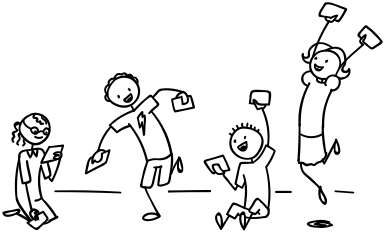
2. Play "Body Touch Race"
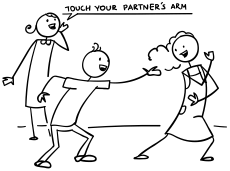 Put students in pairs - you are going to say body vocab and students are going to race to be the first to touch that part on their partner's body. For example, Teacher says, "Touch your partner's arm!" and each pair must try to touch their partners arm before getting their arm touched. It is great fun and quite frantic - in order to work well, make sure the following rules are explained first:
Put students in pairs - you are going to say body vocab and students are going to race to be the first to touch that part on their partner's body. For example, Teacher says, "Touch your partner's arm!" and each pair must try to touch their partners arm before getting their arm touched. It is great fun and quite frantic - in order to work well, make sure the following rules are explained first:
3. Sing "Head, Shoulders, Knees & Toes" song
Your students should have sung this song lots of times by now, so this is a bit of quick fun. Get everyone standing in a line and touching their bodies as they sing along.
We also have a video that you can stream in class to sing along with (Internet connection required):
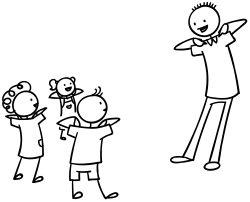 4. Play "Teacher Says"
4. Play "Teacher Says"
This is the game "Simon Says" but using the word "teacher", or your name, instead. Go straight into the game (no explanations necessary) by saying "Teacher says touch your (knees)". Do the action and make sure everyone else follows along. Do a few more "touch your eyes, touch your toes", etc. Then at some point give a command without the "Teacher says" part (e.g. "Touch your mouth"). First time round, everyone will touch their mouth, so make it very clear that they shouldn't do this when you don't say "Teacher says". After a while your students will get the hang of it. Play the game faster and faster. When a student makes a mistake they have to sit the rest of the game out. The last student standing is the winner.
In order to measure themselves, students will need to be familiar with large numbers (of up to 150). If your students have never learned large numbers you will need to spend some time before this lesson teaching these numbers. In this lesson plan we assume your students have had some class time practicing large numbers.
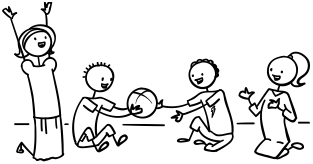 5. Play "Ball Pass Counting Race"
5. Play "Ball Pass Counting Race"
Divide the class up into groups of around 4-8 students (try and have at least 2 groups - although for small classes just one group is fine). Each group should sit in a circle. Each group will pass the ball around the circle and count numbers 1 to 150 as they pass. The first group to finish is the winner. As the activity is running, walk around and listen - any mistakes you hear will mean the team must restart at 1 again.
6. Play "Circle the Number Race"
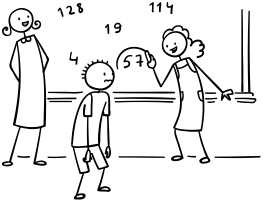 Next, write random numbers (from 1 to 150) allover the board. Divide the class into 2 teams and line up each team, students standing behind each other, so that the front person in the line is facing the board. The first two players on each team will race to circle the number the teacher shouts out to win a point for their team - e.g. the teacher shouts "128!" - both players run to the board, pick up a marker or chalk, and try to circle the number first. They then join the back of their team's line and the next 2 players race.
Next, write random numbers (from 1 to 150) allover the board. Divide the class into 2 teams and line up each team, students standing behind each other, so that the front person in the line is facing the board. The first two players on each team will race to circle the number the teacher shouts out to win a point for their team - e.g. the teacher shouts "128!" - both players run to the board, pick up a marker or chalk, and try to circle the number first. They then join the back of their team's line and the next 2 players race.
7. Play "Write the Number Race"
This is very similar to the above activity, howeverthis time students race to the board to write the correct number: Teacher shouts a number (e.g. "68!") and the two players race to the board, pick up a marker or chalk and write the number. The first player to write the correct number wins a point for their team.
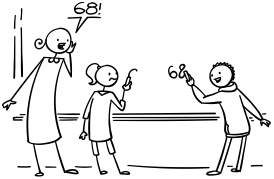
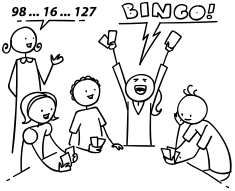 8. Play "Numbers Bingo"
8. Play "Numbers Bingo"
Great fun! Give everyone a piece of paper and tell them to draw a grid (of 5x5 or 8x8, etc. - depending on how long and difficult you want the game to be). Then get students to write any numbers they like (from 1 to 150) in each cell until they filled in their grid. The teacher will be the number caller - to keep things simple, just write down numbers on a piece of paper as you randomly call them out. Students can win points, stars, stickers or prizes for getting lines and full houses.
Now that the key vocabulary has been reviewed we can move onto the fun part of the lesson - measuring parts of the body.
9. Model how to measure
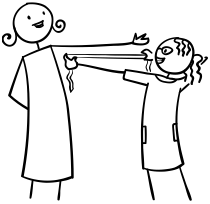 Have everyone sit down, facing the board. Hold out your arm and take a tape measure or ruler. Attempt to measure your arm but make it obvious that it is too difficult to do by yourself. Then ask for a volunteer to help you. Get your volunteer to measure your arm and ask "How long is my arm?". Elicit the number and then teach the word "centimeters". Write on the board "My arms are (73) cm long.
Have everyone sit down, facing the board. Hold out your arm and take a tape measure or ruler. Attempt to measure your arm but make it obvious that it is too difficult to do by yourself. Then ask for a volunteer to help you. Get your volunteer to measure your arm and ask "How long is my arm?". Elicit the number and then teach the word "centimeters". Write on the board "My arms are (73) cm long.
Then ask for another volunteer to help you measure your hair and write the sentence on the board (e.g. "My hair is 20 cm long"). Continue with different volunteers helping to measure different parts of your body as shown in the worksheet "Measurements". By the end you should have 7 sentences written on the board (the same ones as on the worksheet).
10. Pairs measure each other and complete "Measurements" worksheet.
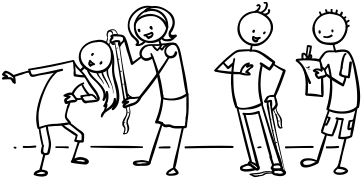 Put everyone in pairs and give each student a worksheet. Pairs work together to measure each other and fill in their worksheets. Encourage everyone to say the measurements rather than just showing on the ruler or tape measure. Also encourage the use of structures, such as (write on the board):
Put everyone in pairs and give each student a worksheet. Pairs work together to measure each other and fill in their worksheets. Encourage everyone to say the measurements rather than just showing on the ruler or tape measure. Also encourage the use of structures, such as (write on the board):
11. Play "Compare Results Line Up"
Now that everyone has completed their worksheets with their measurements we are going to find out who in the class is the tallest, shortest, has the longest and shortest body parts ... in a fun 'line-up' game.
Tell your class they have to stand in a line with the tallest at one end and the shortest at the other end (and everyone else standing in order of height between). This is quite easy to do by sight, so your students should be able to do this without referring to their worksheets. Get them to do it as quickly as possible and set a time limit (e.g. 30 seconds on a timer or stop watch). Then write on the board (under the title "Class Measurements"):
Mika is the tallest.
Luis is the shortest.
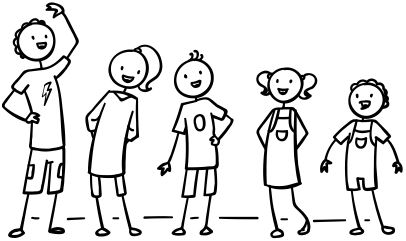
Next, tell everyone to arrange themselves in terms of foot size ... this is not so easy to do by sight, so everyone will have to work together using their worksheets to determine the correct order. Again, give a time limit (e.g. 1 minute). Then write on the board:
Hugo has the longest feet.
Ana has the shortest feet.
Continue with all of the other measurements on the worksheet, writing up the results on the board.
Optional Measuring Activity:
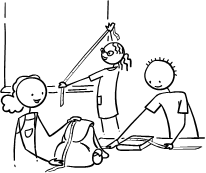 If you have time, you can get your students to measure things in the classroom and write their results down on the board. Give each pair a few items to find and measure, so that each pair measures different things. Each pair writes the results onto the board as they measure each item, such as:
If you have time, you can get your students to measure things in the classroom and write their results down on the board. Give each pair a few items to find and measure, so that each pair measures different things. Each pair writes the results onto the board as they measure each item, such as:
A book is 20 cm long
The window is 200 cm long
My bag is 45 cm long
etc.
12. Read classroom reader "Let’s Measure!"
We’ll finish with a reading activity which reviews all parts of this lesson in a fun and educational way. Before class, download and print off the reader "Let’s Measure!" and the reader worksheet from our website. As you go through each page, get everyone to say their measurements (they can measure themselves as you go through the reader) and write their measurements on their worksheets. Then get everyone to shout out their guesses for the animal measurements. For example:
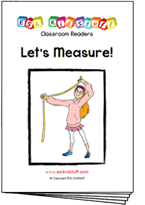 Teacher: (reading from page 2) “Ok. How tall are you?”
Teacher: (reading from page 2) “Ok. How tall are you?”
Students: 132cm! 143cm! 127cm! etc. (everyone shouting out their height)
Teacher: OK! Write your height on your worksheet. (reading) “And how tall do you think a giraffe is?”. Ken, what do you think?
Ken: Um, 300cm?
Teacher: Maybe. How about you Maria, what do you think?
Maria: Um, 400 cm?
Teacher: Ok, everyone write your guess on your worksheet. (turning to page 3 and reading) “An average giraffe is about 600cm tall!”. Wow! That’s really tall! (students write the actual height on their worksheets).
Get the students really involved by asking them lots of questions and encouraging them to shout out their measurements and guesses.
---
Alternatively, watch our video version of the reader (Internet connection required):
1. Assign Homework: "Measure yourself and your family!" worksheet.
2. Wrap up the lesson with some ideas from our "Warm Up & Wrap Up" page.
 Found a mistake?
Found a mistake?
Please let us know
Full access to all resources on ESL KidStuff including lesson plans, flashcards, worksheets, craft sheets,
song downloads, classroom readers, flashcards app and songs app.